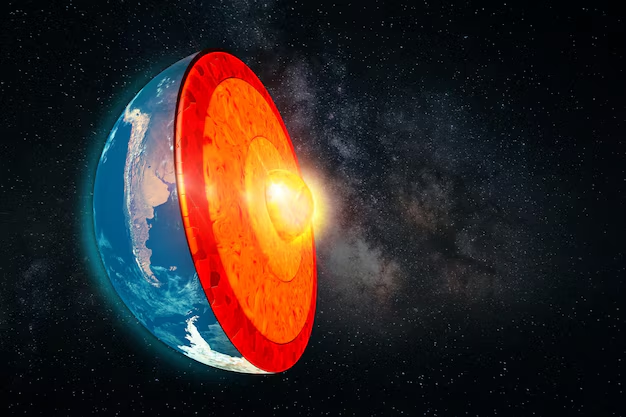Earth’s core slowing down has dramatic implications, potentially altering the length of a day. Discover the latest scientific findings on this phenomenon, its impact on Earth’s magnetic field, and the challenges faced by researchers in studying the inner core’s motion.
Researchers have revealed a significant discovery: Earth’s core slowing down dramatically and now moving in reverse. This deceleration could slightly alter the length of a day on Earth by fractions of a second.
The Enigmatic Inner Core
Deep within Earth lies a solid metal ball that rotates independently of our spinning planet, akin to a top whirling inside a larger top. Discovered by Danish seismologist Inge Lehmann in 1936, this inner core has long fascinated scientists. Its rotation speed and direction have been subjects of intense debate for decades. Increasing evidence suggests that Earth’s core slowing down significantly in recent years, but scientists remain divided on what this signifies.
Challenges in Observing the Core
Observing or sampling Earth’s deep interior directly is impossible. Seismologists gather information about the inner core’s motion by examining seismic waves from large earthquakes that reach this area. By comparing waves of similar strengths that passed through the core at different times, scientists can measure changes in the inner core’s position and calculate its spin. as reported by CNN.
“Differential rotation of the inner core was proposed in the 1970s and ’80s, but it wasn’t until the ’90s that seismological evidence was published,” explained Dr. Lauren Waszek, a senior lecturer of physical sciences at James Cook University in Australia. This growing body of evidence underscores the significance of Earth’s core slowing down.
Interpretation and Debate
Researchers have debated how to interpret these findings. “The challenge of making detailed observations of the inner core, due to its remoteness and limited available data, is the primary reason,” said Waszek. Consequently, studies over the years have disagreed on the rate and direction of the inner core’s rotation relative to the mantle. Some analyses even suggested that the core didn’t rotate at all.
A New Model Emerges
A promising model proposed in 2023 described an inner core that had previously spun faster than Earth itself but was now spinning slower. For a period, the core’s rotation matched Earth’s spin. Then, it slowed even further, eventually moving backwards relative to the fluid layers around it.
At the time, some experts cautioned that more data was needed to support this conclusion. Now, another team of scientists has provided compelling new evidence for this hypothesis. Research published on June 12 in the journal Nature confirms Earth’s core slowing down and supports the 2023 proposal that this deceleration is part of a decades-long pattern of speed changes.
New Findings and Implications
The new findings also confirm that the changes in rotational speed follow a 70-year cycle, said study co-author Dr. John Vidale, Dean’s Professor of Earth Sciences at the University of Southern California’s Dornsife College of Letters, Arts and Sciences. This pattern offers further insight into the periodic nature of Earth’s core slowing down.
“We’ve been arguing about this for 20 years, and I think this nails it,” Dr. Vidale said. “I think we’ve ended the debate on whether the inner core moves and what’s been its pattern for the last couple of decades.”
Remaining Questions
However, not everyone is convinced the matter is settled. The implications of Earth’s core slowing down for our planet remain an open question, with some experts suggesting that Earth’s magnetic field could be affected.
The Inner Core and Earth’s Magnetic Field
Buried about 3,220 miles (5,180 kilometers) deep inside Earth, the solid metal inner core is surrounded by a liquid metal outer core. Composed mostly of iron and nickel, the inner core is estimated to be as hot as the surface of the sun – about 9,800 degrees Fahrenheit (5,400 degrees Celsius).
Earth’s magnetic field pulls on this solid ball of hot metal, causing it to spin. Meanwhile, the gravity and flow of the fluid outer core and mantle exert a drag on the core. Over many decades, the push and pull of these forces have resulted in variations in the core’s rotational speed, leading to Earth’s core slowing down, according to Vidale.
Generating Earth’s Magnetic Field
The movement of metal-rich fluid in the outer core generates electrical currents that power Earth’s magnetic field, which protects our planet from harmful solar radiation. Although the inner core’s direct influence on the magnetic field is not fully understood, scientists reported in 2023 that Earth’s core slowing down could potentially impact it and also slightly shorten the length of a day.
Seismic Evidence
Dr. Vidale and his coauthors observed seismic waves produced by earthquakes in the same locations at different times for this study. They found 121 examples of such earthquakes occurring between 1991 and 2023 in the South Sandwich Islands, an archipelago of volcanic islands in the Atlantic Ocean to the east of South America’s southernmost tip. The researchers also looked at core-penetrating shock waves from Soviet nuclear tests conducted between 1971 and 1974.
The research revealed that Earth’s core slowing down significantly and accelerates at different rates, “which is going to need an explanation,” Dr. Vidale said. The scientists feel that one possibility could be the metal inner core is not as solid as expected.
However, the depth and inaccessibility of the inner core mean that uncertainties remain. Although changes in core spin can be tracked and measured, the researchers highlighted that when Earth’s core slows down, the mantle speeds up. This shift makes Earth move faster, and the length of a day shortens.
“In terms of that effect in a person’s lifetime?” Dr. Vidale said. “I can’t imagine it means much.”
For further insights and comprehensive content, please visit our homepage



